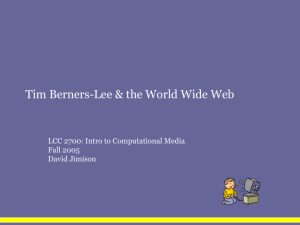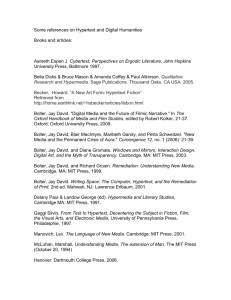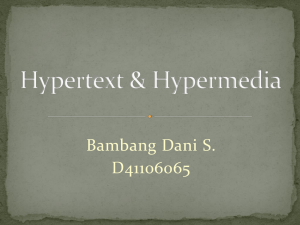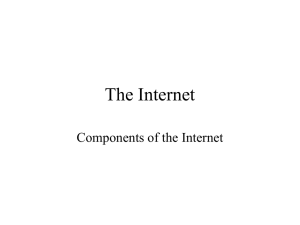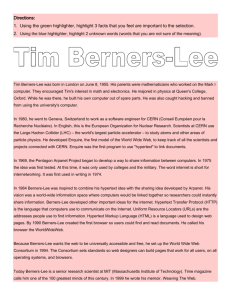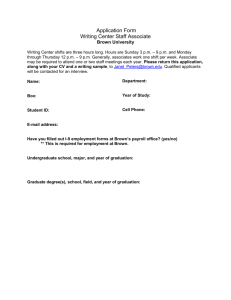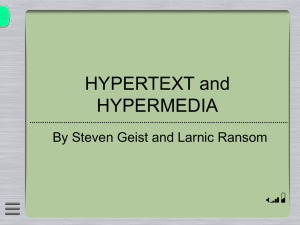Hypertext as a Trope - Clarkson University
advertisement
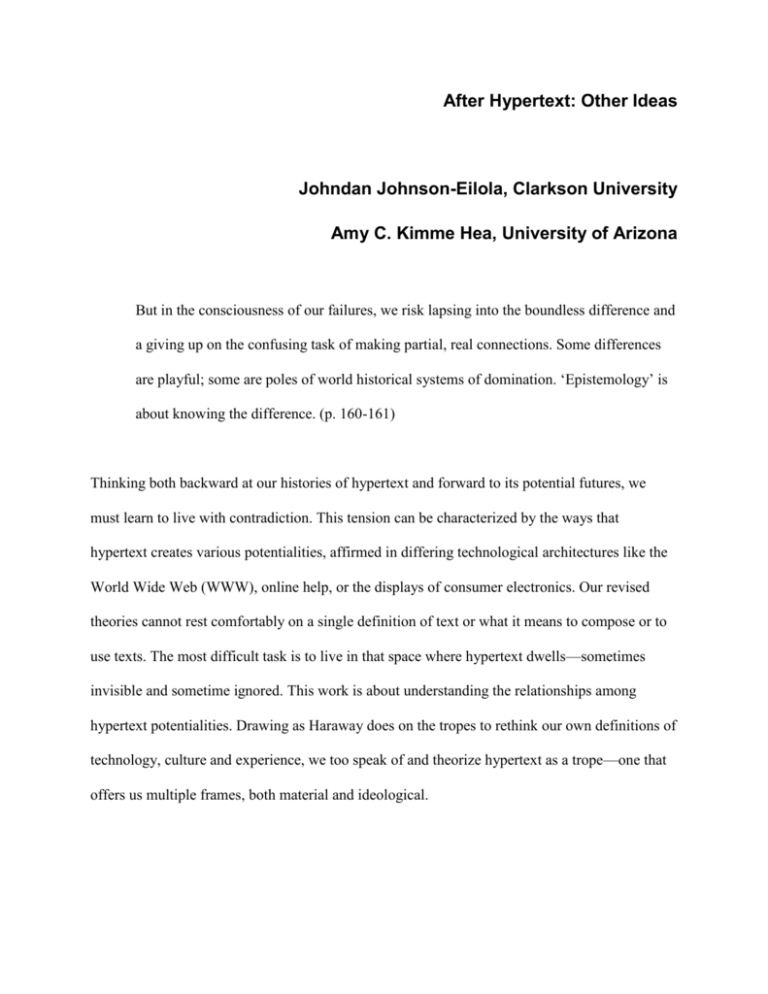
After Hypertext: Other Ideas Johndan Johnson-Eilola, Clarkson University Amy C. Kimme Hea, University of Arizona But in the consciousness of our failures, we risk lapsing into the boundless difference and a giving up on the confusing task of making partial, real connections. Some differences are playful; some are poles of world historical systems of domination. ‘Epistemology’ is about knowing the difference. (p. 160-161) Thinking both backward at our histories of hypertext and forward to its potential futures, we must learn to live with contradiction. This tension can be characterized by the ways that hypertext creates various potentialities, affirmed in differing technological architectures like the World Wide Web (WWW), online help, or the displays of consumer electronics. Our revised theories cannot rest comfortably on a single definition of text or what it means to compose or to use texts. The most difficult task is to live in that space where hypertext dwells—sometimes invisible and sometime ignored. This work is about understanding the relationships among hypertext potentialities. Drawing as Haraway does on the tropes to rethink our own definitions of technology, culture and experience, we too speak of and theorize hypertext as a trope—one that offers us multiple frames, both material and ideological. After Hypertext | 2 Hypertext has always been a multiple and conflicted term, shifting and reconfiguring at the nexus of local tendential forces. Hypertext coalesces: it seems, around a wish of what we want text to be. Contingent. Anchored. Slipping. Caught in a net. Disappearing. In this time and in this place (themselves slipping away), we will use hypertext as a deconstructive hinge, as an opening into which we find (and lose) ourselves. For although we want to avoid claiming a foundation or core truth for hypertext, we also want to make a space that can help us think about the future of hypertext as well as its past. Early Hypertext Discussions/Visions/Desires Despite the fact that hypertext provides the conceptual underpinnings for the WWW (among other things), “hypertext” remains a relatively peripheral term in our culture. During the mid to late 1990s, hypertext seemed too good to be true: the simple node/link technology provided a powerful way for understanding and enacting textual structures that had long been hinted at. Hypertext offered the technological means to challenge the hierarchical nature of relationships between reader/writer and theory/practice. That means is instantiated by several commonly defined aspects of hypertext: nodes and links, nonliterarity, multiplicity, and configurations of images, words, sounds, and other media. The nodes hold different configurations of media and are linked to other nodes also holding different configurations of media. This linking structure opened up new possibilities allowing the emergence of non-linear, multiple perspective hypertexts. Often created in online environments like Hypercard or Storyspace, these hypertexts captivated a range of thinkers. After Hypertext | 3 For literary theorists, hypertext provided the true weapon for assassinating the author: readers now wrested control of the text away, kicked the author in the head a few times for good measure, and skipped off into the dawn of a new day. For poets and creative writers, hypertext provided the foundation for erecting a space for free exploration and innovation, unburdened by the repressive limits of the line. For technical writers, hypertext provided a method for dealing with individual users in varying, concrete situations. Henceforth, rather than force users to tediously thumb through manuals, hypertextual online help would bring the right information (and only the right information) directly to the user, when the user needed, not a moment sooner or later. And, for a few bold writing instructors, hypertext provided the means to challenge the preferred genre of the first-year composition course: the traditional print-based essay. From its most conservative to iconoclastic enactments, hypertext set about shifting our perceptions of writing and reading. Whether we describe it as breaking a line or jamming code, hypertext in these early years held a frightening potential—free the words from the page, the text from the line, the writer and reader from their separateness. Without having to travel all 1,000 plateaus, Deleuze and Guattari would try to teach us that embracing desire and unshackling it from discourses about lack is not easily ignored, especially in the academy. Scholars wanting to test the boundaries of narrative and free story from linearity were not merely advocating a new view of story telling but rather were challenging us to write the world differently. Michael Joyce called on us to not merely think different but to take over and inhabit the text, even if we could never know it completely. Jay Bolter offered us a variety of ongoing spaces as well, linking up epistemologies to technologies in ways that bounded us while they released us. Texts were not contained and their boundaries After Hypertext | 4 engulfed us all in discussions about the non-innocent nature of our always already political and ideological work as writers, readers, and researchers. Moulthrop and Kaplan cautioned us that texts continue to hold power over readers, ensnaring them in possibilities. But in the end, hypertext was itself, as Bolter and Grusin would point out, remediated by other technologies. The WWW, in particular, appears to have exhausted the possibilities of hypertext for many, a move that simultaneously made hypertext a household technology while evacuating it of the revolutionary potentials it once held. More Recent Discussions of Hypertext A decade ago, you could probably fit everyone on the planet who knew anything at all about hypertext onto a single bus. Five years ago, you could probably accommodate everyone who had ever heard the buzzword inside the Hollywood Bowl. Jane Yellowlees Douglas, 1998 Hypertext emerged and then was submerged into a range of technologies, most profoundly perhaps, the WWW. With its Internet “backbone,” the WWW is the now embodied version of hypertext. Perhaps more grotesque in its instantiation—for its masking of certain authoring and reading practices, but the hypertext most present in our daily lives. In terms of contingencies placed upon hypertext as it was envisioned for its early theorists the WWW marked a decided, or After Hypertext | 5 even accidental, shift in how hypertext would be defined in our daily lives. With continued interests in the relationship among our cultural practices and our experiences of hypertext, theorists began noting the differences in collective writings and readings of hypertexts to coding of HTML nodes. This shift is not to suggest a linear progression or to promote the idea that some who worked in Storyspace, HyperCard, or other hypertext programs moved “naturally” to HTML coding. The co-existence of hypertext systems and HTML does signal, however, the ways that visions of hypertext are now further complicated by just what “hypertext” means— what do we mean when we say “hypertext”? Calling for certain considerations in hypertext technology and contexts, Johnson-Eilola (1997) argues that: First, it [hypertext technologies and contexts] must allow writers and readers to work within the space of the texts (rather than downloading them, preserving the purity of the master text). Second, it must encourage more than one person to write within that space (in order to avoid pitting the weight of a published author against a single reader). This call for a dynamic relationship among text, writer, reader, and context holds significance even today as the WWW tracks our Amazon.com purchases as easily as it allows us to publish our web-based syllabi. Thinking through the relationships and desires to preserve the dynamic aspects of reading and writing practices and opening up opportunities to embody the political and social dimensions of literacy practices, hypertext as a means of writing the word, and thus After Hypertext | 6 writing the world, has all of us wondering what connections of openness and indeterminacy remain in the technologies of hypertext writing and reading. We might suggest that rather than searching out a “purer form” or playing into the “god-tricks” that Haraway alerts us to, we need to be less concerned with searching for lost cities of hypertext like Nelson’s Xanadu and search instead for hypertext and its impact on our everyday lives. Rather than dwelling in the absence of a purer form, we believe it is as much a matter of making and remaking hypertext as it is of rearticulating any narratives of history that make situations a matter of inevitability. That is, because hypertext has helped to create the WWW and multimedia texts, we must challenge the idea that hypertext’s contribution is the fulfillment of the WWW. If the WWW is hypertext’s destiny, we reinscribe, yet again, the larger narrative of progress associated with technology: hypertext was developed to shape the Internet—to make it “useful.” This rearticulation of hypertext as a set of non-necessary relations means bringing hypertext and its history into our discussions, mapping hypertext onto the charts of nonlinear writing and reading. Arguing that the multiplicity of links and nodes did not begin with a technology “program,” but rather within a cultural network, as a politics about relationships. What happens if history is erased or conversely if history is made too convenient? It leaves us without a way of reflecting critically on our present; we cannot locate the rupture, and any efforts to discuss the relationships among different hypertexts leaves everyone waiting in an absurdist play for a fictional character who is never to arrive. After Hypertext | 7 Mapping Hypertext as a Making of History During a session at CCCC in the late 1990s, Jay Bolter begins a comment to a room full of people with, “Hypertext...” He pauses, then says half-jokingly, “Does anyone remember hypertext?” But it leaves us wondering, as Jay Bolter did: What happened to hypertext? To locate ourselves in the matrix of hypertext history, we offer some very brief suggestions, then a rough map for where we might go next in our rearticulation of hypertext. 1. Although many of the early (and late) claims for hypertext were way overhyped, one thing seems clear: Hypertext offered something that people wanted: Power over the structure of text. 2. “Power” in text is an odd thing, though, illusory. It’s a mutual construction, not something that’s simply taken or given. 3. Michael Joyce made an early and often quoted distinction between hypertext that invited exploration and one that invited active reader participation in the construction of new links and nodes. We’ve built such an enormous amount of the first type (exploratory) that we’ve almost completely forgotten about the second (constructive). Sure, we can all build new web sites, but the private ownership model (inherent to some extent in the file structure of most operating systems) keeps those sites separate. After Hypertext | 8 4. The point isn’t merely that we need new models of ownership (although we do). It’s not that we need to start building more constructive, collaborative spaces (although we do). The point is that “hypertext” as a concept and a practice was only an analogy for the things that we were practicing. It’s a boundary condition between linear print and something as yet unnamed: it’s the illusion of freedom, not necessarily in an evil, repressive way, but in a We-hoped-so-hard-it-was-true-that-we-started-to-believe-it-wastrue sort of way. 5. Hypertext, as a practice and concept, was simultaneously too powerful and too widely applicable. Here’s another way of thinking about all of this: n + 1. Hypertext was merely a metaphor, a set of suggestions for thinking about communication, for living in the world. Without degenerating into teleological argument about Perfecting True Textual Practices, we want to suggest that hypertext was just a set of training wheels, a choreographer’s chart, a libretto. We were supposed to be doing something with those suggestions, not merely going through the motions. After Hypertext | 9 Hypertext as a Trope If we think through the possibilities that hypertext holds, our work cannot ignore the range of tropes possible to describe hypertext and deploy different frames for critiquing our relationships to this technology and its contexts. If hypertext is about communication and relationships among contexts, people, technologies, and other aspects of our daily lives, we suggest a range of tropes to work against a desire to “fix” or accept a single position for hypertext and to act as one aspect of reflective practice on the roles of hypertext. Noting the promiscuous tendencies of hypertext, those practices cannot be captured in any “essential” way through the tropes we offer or the many others that remain possible. In terms of hypertext as a heuristics for thinking through our relationships to technology, literacy, and one another, the tropes must be thought of as partial articulations with various ethical implications. Kinship Haraway (1991) argues for a sense of kinship predicated on “affinity, not identity” (pg 155). Her cyborg vision of associations made not from obligation but from a strong sense of political and social responsibility is just one way of thinking through hypertext. The associative aspects of hypertext freed writers, readers, and texts from relationships of obligation and helped establish relationships of mutuality. Readers and writers in hypertext do not have to be literally on the same “page” to make meaning and to forge a connection. Instead, writers pursue multiple meanings through a term, a character, even a place. Readers also pursue their own meaning making through the links offered in the hypertext. The relationships are not about having to move from line to line, not a matter of follow the leader in more traditional texts. The sense of relations too is not bound only in word but in the space of hypertext, much in the ways that After Hypertext | 10 Bolter famously suggested some time ago, but perhaps more about the space of a community than that of a technology. We know that the dynamics enacted in the writing and reading of hypertext cannot be fixed to the belief that all of us can equally embrace kinship models of affinity or that any and all texts or any and all writers and readers experience the relational aspects of hypertext in the same way. The metaphor holds the appeal, however, of providing a different conceptualization of the relationships among writer, reader, and text—a conceptualization often spoken of, wished for, and perhaps enacted. The daily practices of how we create, elide, or negotiate connections are brought to the fore in hypertext. The family lines are not as easily drawn in hypertext. The law of the father is disrupted through acts of transgression through dalliances, trysts, and other desires. Even in the most functional of hypertexts, reader questions and negotiations of needs draw upon the contributions of the writer. The reader calls the terms into being as he or she searches for answers. Kinship argues that the relationships among writer, reader, and text are not based upon the dominance of any one of the players. Instead, an affinity kinship model accounts for emerging practices predicated on local relationships where negotiation rather than domination is the preferred practice. Traditional family structures based upon biology as the only category—one that Haraway makes hybrid—argue along the line of the father. This phallologocentrism masks differences and hides relationships that might “infect” the roots of the tree itself. By contrast, affinity kinship implies a lived connection among a community, a connection that comes about from choices, accidents, even transgressions. Kinship allows us to think about context, situation, After Hypertext | 11 experiences, and other often-elided factors, and see them as inseparable from the act of making a hypertext. That ideally that making is not fixed to an end goal, that its making cannot be controlled by any of those involved. Battlefield Hypertext is a battlefield—a plane of contestation with no space for innocence. As we have suggested, early hypertext discussions were tinged with challenge: challenge to text, to reader, to writer. Borne out of, or at least often associated with Vannevar Bush and his memex, hypertext is often theorized as a space poised to challenge conflicts, envisioning the memex as the means to deploy knowledge for the good of the people, for the sake of democracy. Such overtures to hypertext as a site of conflict remain part of the legacy of hypertext theory and practice. As we have suggested hypertext theorists often position their work as speaking from boundaries, noting their always already interest in collapsing the boundaries of tradition for more hybrid forms, dispelling the notions of inside and outside for some middle ground and refiguring our understanding of our selves as contradictory beings made by and always making language, culture, meaning, and technology. This making was not without purpose: more often than not the purpose was to challenge traditional constructions of knowledge making, writing, and reading. Hypertext in print-based forms or in its other technological instantiations as narratives, help files, media pieces, or the WWW may represent different conceptions of hypertext and instantiate different theoretical perspectives, but each form is a boundless plane of challenge, where moving from any node to another creates new potentials for understanding as well as challenge to the After Hypertext | 12 traditional notion of text, to the limits and possibilities of visual and the verbal, to offer of author and reader choice, to the creation of multiple lines of thought and experience, to breaking down the boundaries among academic, corporate, personal, political, virtual, social, cultural, material, visceral, and more. As different instantiations of hypertext emerged and continue to emerge, we are not all equally comfortable with the transformation of the practices negotiated in those different hypertext spaces. Most notably, Joyce (1998) posits that “[t]he web does strike me as a lonely pursuit, something which douses the crispness of difference and community in a salsa of shifting screen….[t]he web too often packages rather than represents the shape of our desires” (p. 166). The ideas of community associated with hypertext are repurposed on the WWW making it a corporate rather than communal space. While Joyce points to many of the flaws of the WWW, the hard won fights over the ways such a space negotiates both the best and worst of our literate practices remains a contention. J. Yellowlees Douglas (1998) also wrangles with the associations of hypertext and the WWW claiming that “[i]ronically, the exposure hypertext has received through the World Wide Web has obscured its more radical and far-reaching possibilities for providing writers with alternatives to linear and singular arguments, particularly for all the philosophers, scientists, educators, and sociologist who long ago rejected objectivism for relativism and who do battle with the monolithic constraints of the printed word on a regular basis” (p. 145). Are constructions of the hypertextual, or not hypertextual enough, aspects of the WWW in many ways yet another way that the dynamic aspects of hypertext as a means of reading, writing, and understanding the world continue remain negotiable? In other words, hypertext thought of as a After Hypertext | 13 battlefield acknowledges it as an emerging space to challenge, grapple, and never regard as reducible the ways we engage in meaning making. The battlefield of hypertext lays out more than one possible interpretation and begs for challenges to all the ways we become comfortable with the normalization of technology. The challenge is not to close down the boundaries of what constitutes the proper place to be called hypertext but rather to remain on our own guard to the ways we construct “enemies” and “allies”—the battles over the making of texts and the privileging print-based epistemologies are still being fought on the front of hypertextual modes. Rhizomatics With the purpose of challenging our assumptions about the ways we engage the world, enact desire, and respond to our cultural contexts, Deleuze and Guattari (1987) offer the rhizome as an ever-shifting organism that challenges the “root-book”. Using their own rhizomatic tropes to redefine not just what constitutes a text but how a text functions, Deleuze and Guattari suggest for us to think of hypertext not just as meaning making or locating a new narrative style of means of creating story but rather as rhizomatic: They argue for writing as “always a measure of something else. Writing has nothing to do with signifying. It has to do with surveying, mapping, even realm that are yet to come” (p. 4-5). In this trope, the hypertext is about a constant making and remaking. In the play of the rhizomatic, we are asked to hold all our sacred beliefs about readers and writers, text and meaning against the larger systems that reify traditional power dynamics. Without a rigid structure to reject, deny, or even hold on to, we read rhizomatic hypertext as a means to challenge binary logics that separate ways of living in language, that After Hypertext | 14 occlude other connections and multiplicities. Rhizomatic views of hypertext look for the features of the rhizome: connections, heterogeneity, multiplicity, asignifying rupture. This looking argues for a bringing together of otherwise separated systems to get at how power flows, how it is imbued, not how it is masked—language is one power system that signals relationships but it cannot be separated from the other ways that power is instantiated in various systems from biology and politics among others. Rhizomatics as a way of thinking about hypertext asks us to maintain the tensions and connections inherent in the network, in all networks. The links created in a hypertext are just as important as the ones we elide. We must remain open to the possibilities denied by formulas of binary logic. Rhizomatic tropes of hypertext acknowledge that no one is in control. That our literate practices, while not arbitrary, are also not predictable. Just as Moulthrop and Kaplan’s student, Karl Crary, futilely attempted to resist hypertext writing, he too was written in hypertext (1994). The ways we engage our own writing, reading, thinking, and living cannot be separated from our enactments of hypertext. Whether those hypertexts be formulated as print, electronic, or written onto other non-discursive forms, hypertext as rhizomatic challenges us to think through multiplicity to resist diagnosing non-traditional ways of thinking to open ourselves up to other logics. Our roles as teachers of literacy is disrupted through rhizomatic views of hypertext. We must remember “[t]he euphoria or the vertigo that one experiences in writing and reading hypertext should not be mutually exclusive conditions; challenging long-held assumptions should be both frightening and exhilarating—and, most of all, constructive” (Johnson-Eilola, 1994, p. 216).We are making and remaking hypertext not just as a shift in the technologies that After Hypertext | 15 are hypertextual but also in our lives as teachers, writers, readers, researchers, and arguably persons engaged in the making of culture. These tropes signal the ways hypertext was, and continues to be, made and remade in our work: affiliation, association, contestation, challenge, non-necessary, multiple, political, infinitely searching for possibility. We cannot suggest a convenient way of articulating hypertext as history or even as technology. Without abandoning all responsibility for these tropes and our naming them, we want to forefront, instead, these tropes are sites fraught with their own problematics. At no point, should we see ourselves as fitting into one of these places, writing the story of hypertext as if it has a beginning or an ending, as if there is really a way to discover what happened to hypertext just as we cannot uncover how hypertext is. Rather these tropes provide a means of negotiating the complexity of hypertext without reducing its past or future to a technological or cultural determination. The best hypertext has to offer us is its complexity.

